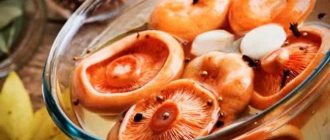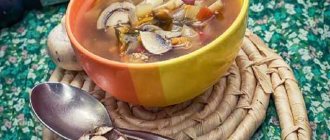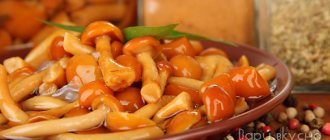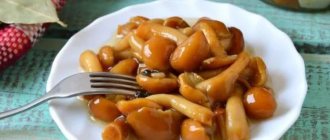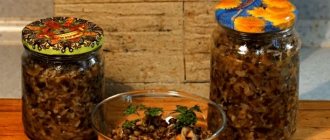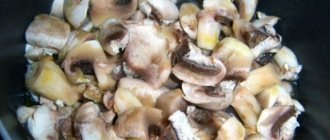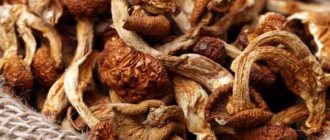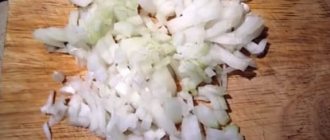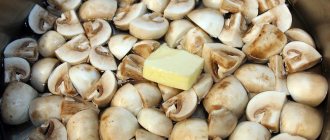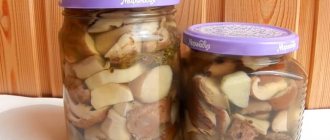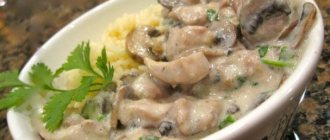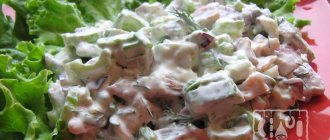Pre-winter and winter are the time for quiet hunting. And there is winter honey fungus - especially interesting for experienced mushroom pickers and beginners. So interesting that it is often passed off as a summer variety by “enterprising” sellers!
What is important to know about it, why it is interesting, what it looks like, how not to confuse it with other mushrooms, when to collect it and how - detailed information, full review, features of collection. And how to cook it deliciously.
Useful properties and calorie content
Flammulina is a type of rowan, an edible mushroom that is widely used in cooking, cosmetology, and oriental medicine.
In Japan, winter mushrooms (also called “enokitake”) are grown on an industrial scale. Flammulina velvety-footed is not very recognized in our area, since it grows in late autumn - early winter until the first frost, but nevertheless it is a very tasty, healthy mushroom that should be given special attention.
Winter mushrooms can be eaten in canned and pickled forms, as part of soups, salads, and side dishes. For cooking, it is better to use young fruiting bodies, as old mushrooms are bitter and can cause poisoning.
Reference! Currently, flammulina ranks third in the world in terms of production among cultivated mushrooms (world production is up to 150,000 tons per year).
The beneficial properties of flammulin are quite extensive. It is enough to mention that Japanese scientists conducted research and identified a special substance, flammulin, in winter honey mushrooms, which significantly inhibits the growth of cancer cells. In addition, the mushroom has the following irreplaceable properties:
- Increases immunity. Flammulins contain thiamine, niacin, potassium, riboflavin, calcium, copper, iron, which act as antioxidants and protect the body from aggressive environmental influences.
- Lowers cholesterol levels.
- Normalizes blood pressure levels.
- Helps reduce weight without dieting. Linoleic acid, which is present in flammulin, breaks down accumulated lipids and fats that come from food.
- Normalizes blood sugar balance, which is very important for people suffering from diabetes.
- Improves the functioning of the gastrointestinal tract due to its high fiber content.
- Improves mental functions. Winter mushroom contains amino acids that are responsible for the functioning of the brain and all parts of the nervous system.
- Prevents the development of allergies, asthma, rhinitis, eczema.
- Accelerates metabolic processes, promotes the rapid elimination of harmful substances and the active absorption of useful ones, and affects the normalization of weight.
The calorie content of Flammulina velvetypodia is 22 kcal per 100 g.
Winter honey fungus: description, photo, what it looks like
Winter honey fungus (Flammulina velutipes), also known as Flammulina velutipes, also known as winter mushroom, collibium, Enokitake - winter saprphyte mushroom. It belongs to the Ryadovkov family, the extensive Flammulina genus, and the Negniuchkov family.
In fact, it is a saprophyte that parasitizes dead wood: it settles on dead wood, in windbreaks, on stumps, on old trees.
The mycellium can rarely be found on coniferous trees: it is a saprophyte of deciduous trees - it often lives on willow, elm, maple, aspen, poplar, and sometimes on birch and rowan.
The mushroom is widespread throughout the central zone and grows in the northern temperate zone. It is considered edible and very popular in Asia.
In recent years, it has become a “fashionable” mushroom in Russia, where it appeared in a “cultivated” form more than 20 years ago. And this is far from being a honey fungus that lives on old stumps, interesting only to bored mushroom pickers: it is a strategically important product!
World production of winter mushrooms is more than 150,000 tons per year!
In industrial areas, winter mushrooms are cultivated in the USA, EU countries, Brazil, Korea, Japan, where they are called “noodle mushrooms,” and in China, where they are grown almost on an industrial scale. In Russia, winter honey fungus received the “trade name” monks.
The nutritional value is mainly provided by young mushrooms. Mature flammulin rows are coarser, tougher, and less digestible.
According to the gradation adopted in the distant times of the USSR, the culture belongs to type IV: the mushroom needs heat treatment before consumption (at least 20 minutes).
Important! Flammulina should not be eaten without prior boiling: the pulp of the mushroom may contain a certain amount of unstable toxins.
Young mushrooms are used in cooking in their entirety, only by cutting off the tip of the stem. In the old ones, only a hat is useful.
What does it look like?
- The fruiting bodies of flammulins are cap-shaped, slightly eccentric.
- The caps of young flammulins are convex, in adults they are flat, honey-brown, fawn, yellow, brown-orange, slimy, without a “skirt,” up to 2-10 cm in diameter.
- The border of the caps along the edge is lighter than the color in the center. Brown spots are observed on the caps of mature fruiting bodies.
- The legs are dense, with fibrous coarse flesh, tubular, yellow-brown above, darker below, velvety, 2-7 cm long, up to 1 cm in diameter.
- The plates of the hymenophore are shortened, sometimes adherent, from light, milky in young mushrooms to ocher. The cover is missing.
- The spores are cylindrical or ellipsoidal, the spore powder is white.
- The pulp is white or creamy, yellowish, tender, somewhat watery, pleasant taste, with a good aroma that does not require the use of many spices.
Preliminary preparation
Winter mushrooms, like most other mushrooms, need to be processed immediately after collection; this process should not be put off for a long time.
Fresh flammulina can be stored in a special container in the refrigerator for no longer than one week.
How to prepare flammulina for further cooking:
- Sort and rinse the fruiting bodies under running water to remove sand and forest debris. If this is difficult to do right away, you can soak the mushrooms in a bowl of water for a while and then repeat the procedure.
- Drain the honey mushrooms in a colander, lightly dry and cut into arbitrary pieces.
- Some mushroom pickers separate the caps from the stems, as the latter can be fibrous and tough. If you don’t want to completely remove it, you can cut off the stem not all the way, but only a third to remove the contaminated part.
Contraindications and possible harm
Winter honey fungus is contraindicated for pregnant women, women during breastfeeding, and children under 10 years of age . It is not recommended to use it for people suffering from diseases of the gastrointestinal tract, liver, and kidneys.
The winter fungus can cause harm by parasitizing the fruit trees of your homestead. It can grow on affected areas of trees and pruned trees. To prevent this process, areas must be treated with oil paint.
Important! Despite the fact that the winter honey fungus is an edible species, it contains unstable toxins. They are neutralized during heat treatment.
Winter honey fungus is a universal mushroom used in cooking, medicine, and pharmacology. Its beneficial properties make this product very popular among mushroom pickers.
How long does it take to cook winter mushrooms?
Before cooking winter mushrooms, you need to carefully process them. Then the mushrooms are placed in a saucepan with plenty of water and cooked for 15–20 minutes from the moment of boiling. The foam must be constantly removed using a slotted spoon.
At the end of cooking, add bay leaf to improve the taste and salt. After boiling, flammulina can be used in any recipe: prepare soups, marinate, fry, pickle.
Marinated Flammulina velvetypodia
Winter mushrooms do not require lengthy preliminary preparation or soaking, so they can be processed quite quickly and easily.
Small specimens are suitable for pickling, but larger ones should not be thrown away; use them to make caviar or pie filling.
The legs can also be cut off at will; this can be omitted. If you nevertheless decide to make the preparation without legs, then you can dry them, and then prepare mushroom powder, which will perfectly complement first courses and become a fragrant seasoning for sauces.
Ingredients:
- honey mushrooms -2 kg;
- water – 1 l;
- salt – 1 tbsp. l.;
- sugar – 2 tbsp. l.;
- vinegar – 250 ml;
- cloves – 2–3 pcs.;
- Bay leaf;
- garlic and grated nutmeg - optional.
How to make winter mushrooms for the winter:
- Place the washed mushrooms in salted water (1 teaspoon per 1 liter of water) and cook for 20-30 minutes from the moment of boiling. Constantly skim off any foam that forms on the surface.
- As soon as the honey mushrooms settle to the bottom, you can turn off the heat and drain the water. Drain the fruits in a colander.
- Prepare the marinade: pour water into a pan, add sugar, salt, other spices, vinegar.
- Place the flammulina in boiling brine and cook for 15 minutes over medium heat.
- Place hot mushrooms in clean, sterilized jars and seal.
- Store in a basement or other cool place.
Reference! Pickled winter mushrooms in a jar are prepared with the addition of mustard seeds, cinnamon, garlic and dill, carrots and onions.
Freezing
There are several ways to freeze winter mushrooms: raw, boiled, fried. Before preparing flammulina, you need to clear the crop of debris, rinse it, and separate the caps from the stems if desired. Only strong young fruiting bodies are suitable for freezing.
How to freeze raw mushrooms:
- There is no need to wash honey mushrooms before freezing them raw. There is no need for excess moisture here. If the mushrooms are very dirty, you can simply wipe them with a damp towel. As a last resort, the fruiting bodies are rinsed under running water and then thoroughly dried on paper towels.
- Next, they are laid out on a tray or cutting board lined with cling film in one layer. Keep in the freezer for some time, and then transfer to bags or containers for long-term storage.
Important! Honey mushrooms frozen in this way do not lose their appearance; they are stewed, fried, soup is prepared, and the same dishes are made as from fresh mushrooms.
To freeze boiled honey mushrooms, you need to rinse the fruiting bodies, peel them, and immerse them in boiling salted water for 15–20 minutes. Place the boiled mushrooms in a colander to drain all the liquid, and then dry them on a paper towel. The fruiting bodies are placed in bags or containers and sent to the freezer.
Important! Only a single portion of mushrooms should be placed in one bag, since re-freezing honey mushrooms is unacceptable.
Frozen fried honey mushrooms are a product that is completely ready to eat after defrosting. To prepare the preparation, you need to boil the peeled mushrooms, rinse and fry in vegetable oil until golden brown.
Then the honey mushrooms are placed on a fine sieve to drain the fat, cooled and packaged in bags. Containers with flammulina are placed in the freezer and used for cooking as needed.
When and where do winter mushrooms grow: collection season
When does winter honey fungus bear fruit, when can it be collected? The collection time begins in December and continues until March. In the cold autumn, you can collect winter gifts from the forest in November.
In general, active fruiting occupies the entire frosty period, while low temperatures do not affect the quality of the mushrooms.
But even when temperatures rise, fruiting continues, even during severe frosts, snowfalls, directly under the snow.
You can collect them frozen or even thawed!
The flammulin mushroom has an interesting feature: high cryoresistance and low cryodestruction.
Cells destroyed by freezing are able to recover at positive temperatures.
That is why flammulina can be collected both in thaws, when mushroom caps are visible in the snowdrifts, and at sub-zero temperatures.
When is the best time to collect winter mushrooms? The peak harvest of flammulina occurs in December, February, and winter thaws. Honey mushrooms grow in large colonies, real bouquets of mushrooms of different ages.
Sometimes collibia climbs onto living trees, and is able to “conquer” a height of 3 m!
Where to look in the forest? On dead wood, clearings, in old forests, on old wood, in stumps. Sometimes they hide in hollows and settle on the branches of old trees.
How fast does Flammulina grow? At temperatures above -30 °C, you should not wait for fruiting - the mycelium is in suspended animation. But with rising temperatures, during thaws, it’s time to open the quiet hunting season.
Important! It is better to collect winter honey mushrooms in spacious, wide containers, large boxes, baskets: the fruiting bodies are very delicate.
At minus °t, the collection of flammulins is carried out carefully: it is important to touch the caps carefully - they can crumble.
Honey mushrooms with legs are cut off with a sharp long knife. During cooking, the entire dark part of the stems of young mushrooms is cut off, and the stems of old ones are cut off completely.
About doubles
Unfortunately, there are many poisonous mushrooms that are quite similar in appearance to flammulina. Some of them belong to the same family.
- Summer. Flammulina is often passed off by unscrupulous sellers as a form that is more familiar to many. The main difference is the fruiting season and external signs: a lighter, faded cap, a ring on the stem, darker spores.
- Ognevka. The second name is Hymenopile bright. It is distinguished by more frequent plates and a ring on a thinner stem.
- Galerina bordered. Has a pronounced ring on the stem.
- Collibia spindlefoot is a representative of the genus Gniuchkov, an inedible mushroom with a red-brown cap, a ring on a twisted stalk, and dark spore powder.
How are winter mushrooms useful? Production is low-cost, production costs are low, and the scale of cultivation is extremely high - there is every reason to assume that this is a commercial crop, the benefits of which are greatly exaggerated.
About the benefits: beneficial properties and controversial issue
Flammulina is used not only in cooking - in Asia (Korea, Japan) it is a component of cosmetics, food additives, and dietary supplements. Briefly about the benefits:
- Like all mushrooms, it surpasses vegetable crops in the amount of protein - 26-33%;
- Contains trace elements in fairly high quantities: in terms of potassium, phosphorus, and zinc content, flammulin is comparable to red meat and milk.
- Supposedly reduces cholesterol, indirectly affecting metabolism.
- Is a hepatoprotector.
- Contains the amino acid ergothioneine, which makes it a powerful antioxidant.
Controversial issues
- There are many unconfirmed rumors about the ability to heal gastrointestinal diseases (ulcers, etc.): coarse fiber is contraindicated.
- There is no strong evidence that the proflamin contained in flammulin has activity against many incurable diseases: there is no direct evidence in evidence-based medicine.
But what about the promises that flammulina is supposedly capable of lowering blood pressure, healing rhinitis and asthma, allergies and eczema, and promoting weight loss?
Alas, these are rumors and speculation: evidence-based medicine does not know such cases. In fact, it is no more useful than other types of mushrooms - but no less. This is a truly valuable food product, but the value should not be exaggerated so as not to be disappointed.
Fried mushrooms with onions and potatoes
The classic flammulina dish is easy to prepare at home. Before frying winter mushrooms, they need to be sorted and cleaned. In addition, frozen mushrooms can be used in cooking, which must be removed from the freezer in advance and allowed to thaw.
Ingredients:
- honey mushrooms – 400 g;
- onion – 1 pc.;
- potatoes – 1 kg;
- vegetable oil – 3 tbsp. l.;
- salt and ground pepper - to taste.
How to cook fried winter honey mushrooms with potatoes:
- Peel the onion, cut it into cubes or half rings.
- Peel the honey mushrooms, rinse and boil in salted water for 20-30 minutes.
- Place the mushrooms in a colander and wait for the liquid to drain. The mushrooms must be dry, otherwise the dish will become watery.
- Potatoes also need to be peeled and cut.
- Pour oil into the pan and fry the onion until golden brown.
- Add honey mushrooms, fry everything together until the moisture evaporates.
- Add potatoes to the pan and cook for another 20 minutes.
- At the very end, add salt and pepper to the dish. If desired, you can add sour cream and herbs.
Cooking in sour cream sauce
This dish is eaten first, it is so popular and tasty. Honey mushrooms in sour cream will complement any side dish, potatoes, vegetable stew, and will be a good appetizer for any table.
For cooking, it is better to choose sour cream with a fairly high percentage of fat content, this will give the treat a pleasant creamy taste.
Ingredients:
- honey mushrooms – 500 g;
- sour cream – 1.5 tbsp;
- butter – 70 g;
- onion – 1 pc.;
- dill – 50 g;
- salt, pepper, bay leaf.
How to cook delicious flammulina:
- Rinse the mushrooms, cut off the lower part of the stem, and once again thoroughly clean them of sand and forest debris.
- Place the washed fruit bodies in a saucepan with boiling salted water and boil for 30 minutes over medium heat, constantly skimming off the foam.
- Drain the flammulina in a colander and rinse well.
- Melt butter in a frying pan.
- Peel and cut the onion into small cubes. Fry it until golden brown.
- Add mushrooms to the pan and cook for 10-12 minutes.
- As soon as the onion becomes transparent, pour in sour cream. Close the lid and simmer everything over low heat for a couple of minutes.
- Salt and pepper the dish, add bay leaves and chopped dill.
When and how is it collected?
The collection season lasts from autumn to spring. You can meet winter mushrooms in large groups. Very often they grow together into a kind of “bouquets”. From mature representatives you only need to take the cap. For young mushrooms, you need to cut off the darkened part of the stem. They are collected during the cold season (December to March). Experienced gardeners recommend using a basket when picking, since mushrooms in a bag can be compressed and lose their shape . Honey mushrooms need to be collected in ecological places, forests, plantings, away from enterprises, factories, factories. This is explained by the ability of fungi to accumulate toxic, harmful substances from the environment.
Description of the salting method
Try salting winter mushrooms cold - this method is very common not only because it saves time and quickly prepares the pickle, but also because the finished product has a pleasant aroma and crispy texture.
Before pickling winter mushrooms for the winter, select the strongest, smallest specimens and separate the caps from the legs if desired.
Ingredients:
- honey mushrooms – 1 kg;
- salt – 2 tbsp. l.;
- black currant leaves – 2 pcs.;
- garlic – 2 cloves;
- allspice and bay leaf – 2 pcs.;
- dill umbrellas – 2 pcs.
Preparing winter mushrooms:
- Clean the mushrooms, rinse, soak for 2-3 hours in salted water to remove dirt, sand and forest debris.
- Rinse and drain in a colander.
- Place the mushrooms on the bottom of a barrel or enamel pan, caps down.
- Thoroughly salt the first layer, add spices and bay leaf.
- Peel the garlic and cut it into slices.
- Continue adding layers of mushrooms, sprinkling them with spices, salt and garlic.
- The last layer should be currant leaves.
- Set the pressure, press the mushroom mass.
- As soon as the juice begins to stand out, you need to place several layers of gauze under the load. Honey mushrooms should be salted for 2 weeks in a cold room.
Important! After the salting period has expired, you need to transfer the flammulina into sterile, clean jars, fill with brine and seal with nylon lids.
Description of the Flammulina mushroom
Winter honey fungus The flammulina cap is 2-9 cm in diameter, initially convex, then flat, smooth, slimy, rusty-yellow, yellow-brown, darker towards the center, shiny when dry.
The leg of Flammulina is 3-10×0.5-1.0 cm, central, cylindrical, formed, dense, hard, yellowish at the plates, brown-brown, black-brown towards the base, velvety pubescent, root-like elongated.
The flesh of the flammulin mushroom is soft, yellowish, with a mild pleasant taste and a faint mushroom odor.
Flammulina plates are weakly adherent or free, frequent, thin, light, yellowish-fawn.
Flammulina spore powder is creamy white. The spores of the velvety-footed flammulina are 8-9×5-6 µm, oval, smooth, colorless.
Flammulina
Where does flammulina grow? Flammulina grows on wood, in hollows, on the stumps of deciduous and, occasionally, coniferous trees, in large groups and clumps. On old deciduous wood. Honey mushrooms bear fruit especially abundantly on tall and thick old aspen, poplar, willow and maple stumps and logs lying on the ground.
Flammulina grows on trees and stumps. Winter flammulina honey mushrooms can settle in a garden with fruit trees, gradually destroying them.
On the wood of deciduous (rarely coniferous) trees in forests and gardens. Prefers elms, poplars, willows, and beeches. All year round, but mainly from November to February. In summer it occurs very rarely, and in small groups. In spring it can grow in large quantities.
The fungus prefers the wood of deciduous trees, especially poplar and willow.
Flammulina belongs to the ecological group of xylophyte mushrooms, that is, mushrooms growing in forests on stumps, dead wood, fallen deciduous trees and weakened trees.
Flammulina growth time: more abundantly - from October to December, and during thaws - also January and February. Our reports on the search for winter honey fungus are here.
This mushroom is also called winter honey fungus, winter mushroom; in Latin, winter honey fungus is called flammulina velutipes, and in Ukrainian - winter mushroom.
Drying at home
Drying honey mushrooms is the simplest and most versatile way to prepare mushrooms for the winter, because it allows you to preserve the beneficial substances, taste and aroma of forest gifts. Try drying flammulina and then use it in soups, pizza, pasta, sauces and other delicious dishes.
Mushrooms should be prepared in advance: they are sorted depending on ripeness, rotten, old fruiting bodies are thrown away.
Another peculiarity of drying is that the mushrooms are not washed, but only wiped with a dry cloth so that they do not absorb a lot of liquid.
Honey mushrooms are dried on a thread, in the microwave, in an electric dryer and in the oven. Let us dwell in more detail on the last method, since it is accessible and simple:
- The prepared flammulina caps should be laid out on a baking sheet previously lined with parchment.
- Place it in the oven, preheated to 50C for 2-3 hours, so that the mushrooms dry out, gradually losing moisture.
- As soon as the caps become sticky, the temperature is increased to 75C. The door is left ajar - there is good air circulation in the oven.
- From time to time you need to turn the caps over so that they do not burn and dry evenly.
Important! When dried, honey mushrooms lose up to 90% of their moisture, so from 10 kg of fresh mushrooms you will get one and a half kilograms of dry product.
How to distinguish winter mushrooms from false ones
Flammulina cannot be mistaken for another type of mushroom. The concept of “false winter mushrooms” or “double” is relative and conditional. This mushroom has individual characteristics. By some signs you can easily distinguish winter mushrooms from false ones.
The fact is that poisonous species grow in a different seasonal period. But it is still important to know about some of the distinctive features of edible mushrooms.
Real edible mushrooms look like this:
- Uneven color of the cap: from brown in the center to honey closer to the edges.
- The presence of mucus on the surface of the mushroom, even after heat treatment.
- The stem of the mushroom has the shape of a cylinder, even and smooth to the touch.
Important! There is one type of mushroom that looks like the winter honey fungus. This is a bordered gallery.
It falls under the concept of “false” and is poisonous, the photo is presented below. It is unlikely to be seen at the same time, since they ripen in different time periods.
Photo of galerina mushroom:
The main way to distinguish winter mushrooms from false ones is to pay attention to the mushroom stem. Flammulina has a ring on it.
If you wish, you can look at and compare photographs of Flammulina and Galerina: there is a difference.
Video of the difference between winter mushrooms and false mushrooms (helerina):
Having studied in detail the topic “winter honey mushrooms: photos, how to distinguish them from other types of mushrooms,” you can easily make the right choice.
A simple recipe for canning in jars for the winter
If you don’t know how to make winter mushrooms, a recipe for pickled mushrooms with dill and currant leaves will help you with this. The mushrooms are piquant and crispy, thanks to the tannins contained in currants.
Ingredients:
- flammulina – 3 kg;
- water for marinade – 1.5 l;
- sugar – 3 tbsp. l.;
- bay leaf – 10 pcs.;
- garlic – 4 cloves;
- salt – 4 tbsp. l.;
- cloves – 3 pcs.;
- black pepper – 10 pcs.;
- table vinegar 9% - 80–100 ml;
- currant leaf or dill umbrellas.
Recipe for winter honey mushrooms in jars for the winter:
- Peel, rinse and boil the mushrooms for half an hour in salted water.
- Prepare the marinade, to do this, pour water (1.5 l) into a saucepan, add salt, sugar, and other spices.
- Bring the brine to a boil.
- Immerse the boiled mushrooms in it and cook for 15–20 minutes over low heat. It is important to constantly ensure that foam does not form on the surface of the marinade (it is removed with a slotted spoon).
- As soon as the honey mushrooms sink to the bottom of the pan, you can turn off the heat.
- Transfer the still hot mushrooms into clean, sterilized jars and pour boiling marinade over them.
- Seal the workpiece and store it in a cool place.
Flammulina - edible winter mushroom
Winter in our city has turned out to be unusually warm. Nature reacts sensitively to everything that happens—a very unusual picture is revealed to the attentive gaze of the observer. Trees and bushes right within the city are covered with hundreds of mushrooms!
This mushroom is completely unknown to most St. Petersburg lovers of quiet hunting. However, it is not at all rare, and you don’t have to travel far to get it: whole bunches of flammulina
meet right within the city - in Udelny Park, a hundred meters from Moskovsky Prospekt, in the Forestry Academy Park, on St. Isaac's Square, among colorful sightseeing buses and frozen passers-by.
The scientific name of the mushroom is Flammulina velutipes. Sometimes you can hear amazing poetry in boring Latin names - the generic name literally translates as “fire mushroom”
, and the specific one - as “
velvety-footed”
.
In general, the name matches the appearance - bright yellow, honey-colored mushroom caps “burn” like lights in the dark winter forest. Specifically in winter - this year I had to collect them in January! So if you come across a person with a basket in the forest among the snowdrifts in winter, do not rush to twist your finger to your temple and call an ambulance. Someone just knows more about mushrooms than you.
Mushroom is also called winter honey fungus
- in the warmer regions of Russia, it pleases mushroom pickers all winter, every year and without interruption.
The mushroom is beautiful and decorative in its own way. The smooth, shiny cap of adult flammulin reaches 5-6 centimeters, the leg is about the same in length. The bulk of the fruiting bodies are smaller - from one to three centimeters. The smell is strong, pleasant, really mushroom. In terms of where it grows, flammulin is unpretentious; in the forest it can be found on living deciduous trees, as well as on stumps, dead wood, and brushwood. In the city, flammulina is most often found in parks and squares among willows, at a height of about half a meter above the ground.
The mushroom cap is usually covered with a layer of mucus, which protects it from light frosts. In the process of evolution, flammulin acquired an unusual property - the water in its cells is replaced by a peculiar glycerol complex that prevents ice from crystallizing. If frost hits, that’s also okay. A few days of thaw are enough - the mushroom will thaw and grow again. So don’t get lost next fall, the main fruiting of this mushroom in our country occurs at the end of October-November. By the way, in the gloomy late autumn, when you give up and don’t want to do anything, a walk through the forest wonderfully improves your mood. The winter forest is surprisingly deserted and quiet. During a whole day of walking, you most likely will not meet anyone, so there will be no one to laugh at your snow-covered basket and mushroom picker’s cane.
A rule that applies not only to flammulina, but also to mushrooms in general - mushrooms collected within the city limits cannot be eaten! The fact is that mushrooms very actively accumulate various substances, including substances harmful to the human body. This rule also applies to mushrooms grown in close proximity to roads and railways, around large industrial enterprises and similar environmentally unfavorable places.
To be fair, we note that flammulina is far from the only mushroom that pleases us during the “non-mushroom” season. Well -known mushrooms
can be collected in late autumn. Right up to the snow, in the forest you can find some rows of trees, oyster mushrooms growing abundantly on wood, and hygrophora cheekily sticking out among the fallen needles. But only flammulina is capable of continuing growth after severe frosts of many days. By the way, the optimal temperature for the beginning of fruiting for this mushroom is 3-5 degrees.
Flammulina soup
This dish can be eaten during Lent; it is rich, light, and at the same time quite filling. The first can be prepared from fresh mushrooms, but soup is also prepared from frozen winter mushrooms.
Ingredients for the soup:
- honey mushrooms – 400 g;
- potatoes – 500 g;
- onion – 1 pc.;
- carrot – 1 pc.;
- vegetable oil – 75 ml;
- salt pepper, chopped herbs - to taste.
Winter mushroom soup - recipe:
- Flammulin needs to be thoroughly cleaned, washed and cut into small pieces.
- Next, you need to pre-boil the honey mushrooms for 10-15 minutes, then wash and drain in a colander.
- Pour boiled mushrooms with fresh cold water and place the container on medium heat.
- Peel the vegetables: cut the potatoes into cubes, carrots and onions into strips.
- As soon as the mushroom broth boils, add the potatoes and simmer for 10 minutes.
- Fry carrots and onions in vegetable oil until golden brown.
- Place the roast into the soup when the potatoes are completely cooked.
- Simmer over low heat for 5–7 minutes, add salt and season the first dish.
- Pour the soup into deep plates, serve with sour cream and chopped herbs, black bread croutons.
